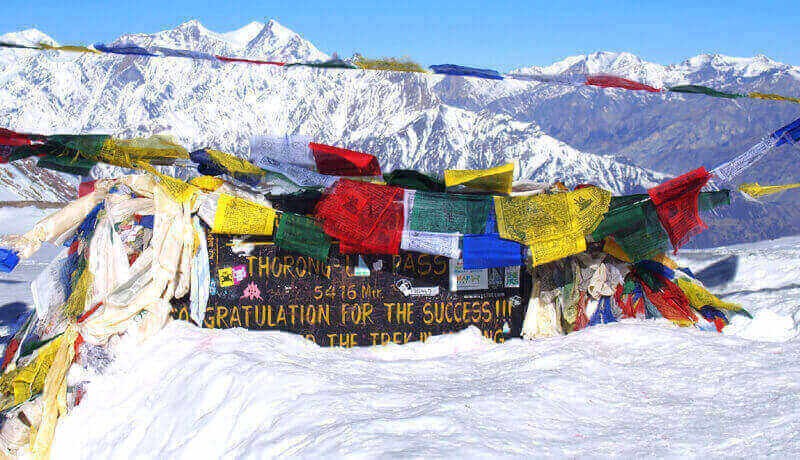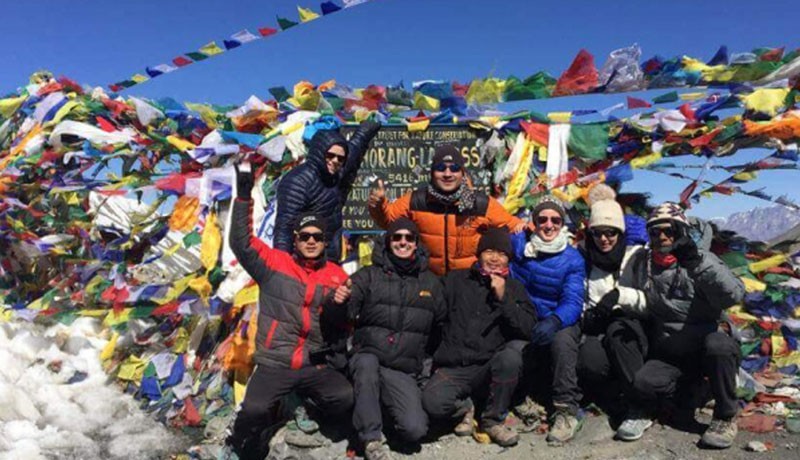Trip Details
-
Destination: Nepal
-
Trip Difficulty: Moderate
-
Trip Style: Trekking and sightseeing
-
Transport: Deluxe tourist bus & private car
-
Food: Breakfast,Lunch and Dinner
-
Accommodation: Hotel, lodge (tea house)
-
Group Size: 1 - 12 Pax
-
Max Elevation: 5,415 meters, Thorong - La pass, stunning views
-
Starts in: Kathmandu
-
Ends in: Kathmandu
-
Approx. walking: 6-7 hours
Highlights
- Marvel at the Picturesque Marshyangdi River Valley, surrounded by lush green forests, cascading waterfalls, and dramatic mountain vistas.
- Immerse Yourself in Manang’s Tibetan Buddhist Culture, exploring ancient monasteries and traditional highland villages.
- Conquer the Legendary Thorong La Pass (5,416m)—one of the world’s highest and most exhilarating trekking passes.
- Visit the Sacred Muktinath Temple, a revered pilgrimage site nestled in the rugged landscapes of the Mustang region.
- Trek Through the Wind-Swept Kali Gandaki Valley, home to the world’s deepest gorge, flanked by towering Himalayan peaks.
- Catch a Spectacular Sunrise from Poon Hill (3,210m), where golden hues illuminate the Annapurna and Dhaulagiri ranges.
- Witness Breathtaking Landscapes, from subtropical forests and terraced fields to alpine deserts and high mountain passes.
About Annapurna Circuit Trek
The Annapurna Circuit Trek is one of Nepal’s most renowned and diverse trekking adventures, offering breathtaking Himalayan vistas, rich cultural experiences, and a variety of landscapes. Also known as the Round Annapurna Trek, this route takes you through lush river valleys, alpine meadows, and high-altitude deserts, culminating in the crossing of Thorong La Pass (5,416m)—one of the highest trekking passes in the world.
This trek connects the Annapurna and Mustang regions, showcasing the stunning contrast between subtropical forests and the arid terrain of Lower Mustang. Along the way, trekkers experience Tibetan Buddhist culture in Manang, visit the sacred Muktinath Temple, and trek through the dramatic Kali Gandaki Gorge, the world's deepest gorge. The journey concludes with a scenic sunrise from Poon Hill (3,210m), providing a spectacular panoramic view of the Annapurna and Dhaulagiri ranges.
Trek Duration & Route
The Annapurna Circuit Trek typically lasts 14 to 18 days, depending on the itinerary and acclimatization schedule. The trek begins from Besisahar, following the Marshyangdi River Valley before reaching Manang (3,540m) for acclimatization. After crossing Thorong La Pass (5,416m), the descent takes you through Muktinath, Kagbeni, and Jomsom, showcasing the unique beauty of Lower Mustang. The final stretch passes through Tatopani and Ghorepani, ending with a sunrise trek to Poon Hill before descending to Nayapul and driving to Pokhara.
Best Seasons for Trekking
The ideal times for the Annapurna Circuit Trek are:
- Spring (March–May): Clear skies, blooming rhododendrons, and moderate temperatures.
- Autumn (September–November): Stable weather, crisp mountain views, and vibrant local festivals.
Permits Required
Trekkers need the following permits for the Annapurna Circuit:
- Annapurna Conservation Area Permit (ACAP) – Required to enter the Annapurna Conservation Area.
- Trekkers’ Information Management System (TIMS) Card – Ensures trekker safety and registration.
Why Choose Adventure Bound Nepal?
- Experienced Local Guides & Porters ensuring a safe and enriching journey.
- Well-Planned Itineraries with proper acclimatization and flexibility.
- Reliable Logistics & Permit Assistance for a hassle-free trekking experience.
- Ethical & Sustainable Trekking Practices with minimal environmental impact.
Useful Information
Trek Difficulty & Fitness Requirements
The Annapurna Circuit Trek is considered moderate to challenging, depending on the route, pace, and weather. Reaching over 5,400 meters at Thorong La Pass, this trek demands good cardiovascular fitness and endurance.
While prior trekking experience is beneficial, it's not mandatory for well-prepared trekkers. Begin training at least 8–10 weeks in advance with cardio exercises, strength workouts, and practice hikes carrying a daypack. Built-in acclimatization days (e.g., in Manang and Muktinath) help reduce the risk of altitude sickness.
Accommodation & Meals
Accommodation is provided in locally-run teahouse lodges offering basic but comfortable twin-sharing rooms with shared bathrooms. Heating is rarely available in rooms.
Meals include traditional Nepali Dal Bhat, Tibetan dishes like thukpa and momos, as well as simple continental options. Expect to pay extra for amenities such as hot showers, Wi-Fi, and device charging (typically NPR 100–500 per service).
Water can be purchased as bottled, filtered, or boiled. For health and sustainability, bring water purification tablets or a UV purifier.
Packing List for Annapurna Circuit Trek
Essential clothing and gear:
- Sturdy, waterproof trekking boots
- Moisture-wicking base layers and insulating mid-layers
- Down or synthetic jacket for warmth
- Waterproof jacket and trousers
- Warm hat, sun hat, and gloves
- Sleeping bag rated to at least -10°C (14°F)
- Trekking poles and sunglasses with UV protection
- Daypack with rain cover
Additional items:
- First aid kit and personal medications
- Headlamp with extra batteries
- Biodegradable toiletries, wet wipes, and hand sanitizer
- Sunscreen (SPF 50+), lip balm, and insect repellent
- Power bank or solar charger
Transportation Details
The journey starts with a drive from Kathmandu to Bhulbhule (approx. 6–7 hours).
The trek ends in Birethanti, from where you drive to Pokhara. You can return to Kathmandu via:
- Flight: 25 minutes from Pokhara (more comfortable option)
- Tourist bus: 7–8 hours
Travel Insurance & Emergency Support
Travel insurance is mandatory. Ensure your policy covers:
- Trekking at altitudes up to 5,000 meters
- Medical expenses and evacuation by helicopter
- Trip cancellation and interruption
Carry a printed and digital copy of your insurance policy and share it with your guide for emergency planning.
Altitude Sickness & Acclimatization Tips
Altitude sickness can affect anyone. Acclimatization is critical to safety:
- Rest days in Manang support adjustment
- Stay hydrated — aim for 3–4 liters per day
- Ascend gradually and avoid alcohol or overexertion
Symptoms of AMS: Headache, nausea, dizziness, fatigue. If symptoms worsen, descend immediately and notify your guide.
Cultural Etiquette & Local Customs
- Always walk clockwise around religious monuments like stupas and prayer wheels
- Remove shoes before entering homes or monasteries
- Ask for permission before taking photos of people or sacred spaces
- Dress modestly and avoid public displays of affection
Connectivity & Communication
Wi-Fi is available in many teahouses for a fee, but becomes limited or unavailable at higher elevations.
Mobile coverage (NCELL/NTC) exists in some lower-altitude areas but should not be relied upon.
Money & Payments
- ATMs are only available in Kathmandu and Pokhara — withdraw cash before starting the trek
- All teahouses accept cash payments only (Nepali Rupees)
- Daily expenses: NPR 1,000–2,500 per person for food, drinks, and extras
- Tipping: Guide: $5–10/day, Porter: $3–6/day (or pooled if in a group)
Safety & Trekking Guidelines
- Always trek with a licensed guide and porter for safety and local insight
- Avoid trekking alone, especially in remote areas
- Stick to marked trails and follow local regulations
- Be mindful of weather, landslides, and changing trail conditions
- Practice Leave No Trace principles — pack out waste, avoid plastic, and protect natural and cultural heritage




